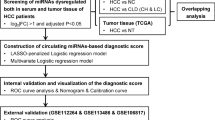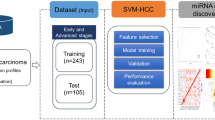Abstract
MicroRNAs (miRNAs) play important roles in liver pathologies and they are potential biomarkers for diagnosis of liver diseases progression. Changes in miRNA sera expression can be used as non-invasive biomarkers for hepatocellular carcinoma (HCC). The aim of the study was to identify the miRNome profiling of HCC and its diagnostic value in distinguishing HCC from healthy individuals. Expression profiles of miRNAs in serum samples of 20 HCC patients and 10 healthy controls were detected. Whole miRNome profiling was done using next generation sequencing. Receiver operating characteristic (ROC) analysis was performed to assess the diagnostic performance of the deregulated miRNAs for discriminating HCC cases from healthy controls. MiRNA 142 was highly expressed in HCC (P value = 0.023) while miRNAs 191, 22, and 126 were higher in the controls (P value = 0.005, 0.034, 0.010 respectively). We have identified 5 novel miRNAs and they were highly expressed in HCC than controls. Analysis of ROC curve demonstrated that these deregulated miRNAs can be used as a reliable biomarker for detection of HCC with high diagnostic accuracy (AUC = 0.93). We have detected a panel of serum miRNAs that can be used as a reliable noninvasive screening biomarker of HCC. The study recommends further research to shed light on a possible role of the newly discovered novel miRNAs in HCC pathogenesis.


Similar content being viewed by others
Change history
10 June 2020
The correct spelling of the 7th authors' name is Mona Watany.
References
European Union HCV Collaborators (2017) Hepatitis C virus prevalence and level of intervention required to achieve the WHO targets for elimination in the European Union by 2030: a modelling study. Lancet Gastroenterol Hepatol 2:325–336
Forner A, Reig M, Bruix J (2018) Hepatocellular carcinoma. Lancet 2018(391):1301–1314
Akinyemiju T, Abera S, Ahmed M et al (2017) (2017): The burden of primary liver cancer and underlying etiologies from 1990 to 2015 at the global, regional, and national level. JAMA Oncol 3:1683–1691
Abd-Elsalam S, Elwan N, Soliman H et al (2018) (2018): Epidemiology of liver cancer in Nile delta over a decade: a single-center study. South Asian J Cancer 7(1):24–26
Ziada DH, El Sadany S, Soliman H et al (2016) Prevalence of hepatocellular carcinoma in chronic hepatitis C patients in Mid Delta, Egypt: a single center study. J Egypt Natl Cancer Inst 28(4):257–262
Rashed WM, Kandeil MAM, Mahmoud MO et al (2020) Hepatocellular Carcinoma (HCC) in Egypt: a comprehensive overview. J Egypt Natl Cancer Inst 32:5
Sheta E, El-Kalla F, El-Gharib M et al (2016) (2016): Comparison of single-session transarterial chemoembolization combined with microwave ablation or radiofrequency ablation in the treatment of hepatocellular carcinoma: a randomized-controlled study. Eur J Gastroenterol Hepatol 28(10):1198–1203
Negm O, Abou Saif S, El Gharib M et al (2017) (2017): Role of low-molecular-weight heparins in prevention of thromboembolic complication after transarterial chemoembolization in hepatocellular carcinoma. Eur J Gastroenterol Hepatol 29(3):317–321
Watany M, Badawi R, Elkhalawany W et al (2017) Study of Dickkopf-1 (DKK-1) gene expression in hepatocellular carcinoma patients. J Clin Diagn Res 11(2):OC32–OC34
Elwan N, Salem ML, Kobtan A et al (2018) (2018): High numbers of myeloid derived suppressor cells in peripheral blood and ascitic fluid of cirrhotic and HCC patients. Immunol Invest 47(2):169–180
Abdelfattah AAM, Rizk F, Hawash N et al (2018) Randomized trial of preoperative administration of oral pregabalin for postoperative analgesia in patients scheduled for radiofrequency ablation of focal lesions in the liver. Int J Hyperth 34(8):1367–1371
El-Sharawy S, Negm OE, Abd-Elsalam S et al (2020) Study of Toll-like receptor 3 gene polymorphism as a novel risk factor for HCV-related Hepatocellular Carcinoma in Egypt. Curr Cancer Drug Targets. https://doi.org/10.2174/1568009620666200319102929
El-Gebaly F, Abou-Saif S, Elkadeem M et al (2019) Study of serum soluble programmed death ligand 1 as a prognostic factor in hepatocellular carcinoma in Egyptian patients. Curr Cancer Drug Targets 19(11):896–905
Clark P (2016) Serum markers for hepatocellular carcinoma. Clin Liver Dis 8(2):29–33
Diaz G, Melis M, Tice A et al (2013) Identification of microRNAs specifically expressed in hepatitis C virus-associated hepatocellular carcinoma. Int J Cancer 133:816e824
Almas I, Afzal S, Idrees M et al (2017) Role of circulatory microRNAs in the pathogenesis of hepatitis C virus. VirusDis 28(4):360–367
Tao J, Jiang L, Chen X (2018) Roles of microRNA in liver cancer. Liver Res 2:6172
Murakami Y, Yasuda T, Saigo K et al (2006) Comprehensive analysis of microRNA expression patterns in hepatocellular carcinoma and non-tumorous tissues. Oncogene 25(17):2537–2545
Hou J, Lin L, Zhou W et al (2011) Identification of miRNomes in human liver and hepatocellular carcinoma reveals miR-199a/b-3p as therapeutic target for hepatocellular carcinoma. Cancer Cell 19(2):232–243
Fornari F, Gramantieri L, Ferracin M et al (2008) MiR-221 controls CDKN1C/p57 and CDKN1B/p27 expression in human hepatocellular carcinoma. Oncogene 27(43):5651–5661
Si ML, Zhu S, Wu H et al (2007) miR-21-mediated tumor growth. Oncogene 26(19):2799–2803
Xu T, Zhu Y, Xiong Y et al (2009) MicroRNA-195 suppresses tumorigenicity and regulates G1/S transition of human hepatocellular carcinoma cells. Hepatology 50(1):113–121
Cheng J, Zhou L, Xie QF et al (2010) The impact of miR-34a on protein output in hepatocellular carcinoma HepG2 cells. Proteomics 10(8):1557–1572
Wong QWL, Lung RWM, Law PTY et al (2008) MicroRNA-223 is commonly repressed in hepatocellular carcinoma and potentiates expression of Stathmin1. Gastroenterology 135(1):257–269
Xu C, Liu S, Fu H et al (2010) MicroRNA-193b regulates proliferation, migration and invasion in human hepatocellular carcinoma cells. Eur J Cancer 46(15):2828–2836
Zhang W, Kong G, Zhang J et al (2012) MicroRNA-520b inhibits growth of hepatoma cells by targeting MEKK2 and cyclin D1. PLoS ONE 7(2):Article ID e31450
Garofalo M, di Leva G, Romano G et al (2009) miR-221&222 regulate TRAIL resistance and enhance tumorigenicity through PTEN and TIMP3 downregulation. Cancer Cell 16(6):498–509
Súarez Y, Sessa WC (2009) MicroRNAs as novel regulators of angiogenesis. Circ Res 104(4):442–454
Cheng G (2015) Circulating miRNAs: roles in cancer diagnosis, prognosis and therapy. Adv Drug Deliv Rev 81C:75–93
Otsuka M, Kishikawa T, Yoshikawa T et al (2017) MicroRNAs and liver disease. J Hum Genet 62:75–80
Jin Y, Wong YS, Goh BKP et al (2019) Circulating microRNAs as potential diagnostic and prognostic biomarkers in hepatocellular carcinoma. Sci Rep 9(1):10464
Huang J, Borchert GM, Dou D, Huan J, Lan W, Tan M, Wu B (2017) Bioinformatics in microRNA research. Part of the Methods in Molecular Biology Book Series (MIMB, volume 1617). Humana Press, New York
El-Hefny M, Fouad S, Hussein T et al (2018) Circulating microRNAs as predictive biomarkers for liver disease progression of chronic hepatitis C (genotype-4) Egyptian patients. J Med Virol 91:93–101
El-Guendy N, Helwa R, El-Halawany M et al (2016) The liver microRNA expression profiles associated with chronic hepatitis C virus (HCV) genotype-4 infection: a preliminary study. Hepat Mon 16(4):e33881
Hu Y, Guo X, Wang J et al (2018) A novel microRNA identified in hepatocellular carcinomas is responsive to LEF1 and facilitates proliferation and epithelial-mesenchymal transition via targeting of NFIX. Oncogenesis 7:22
Bae HJ, Noh JH, Kim JK et al (2557e) MicroRNA-29c functions as a tumor suppressor by direct targeting oncogenic SIRT1 in hepatocellular carcinoma. Oncogene 33:2557e2567
Sheng Y, Ding S, Chen K et al (2014) Functional analysis of miR-101–3p and Rap1b involved in hepatitis B virus-related hepatocellular carcinoma pathogenesis. Biochem Cell Biol 92:152162
Liu AM, Xu Z, Shek FH et al (2014) MiR-122 targets pyruvate kinase M2 and affects metabolism of hepatocellular carcinoma. PLoS ONE 9:e86872
Wang Y, Hu C, Cheng J et al (1255e) MicroRNA-145 suppresses hepatocellular carcinoma by targeting IRS1 and its downstream Akt signaling. Biochem Biophys Res Commun 446:1255e1260
Shi KQ, Lin Z, Chen XJ et al (2015) Hepatocellular carcinoma associated microRNA expression signature: Integrated bioinformatics analysis, experimental validation and clinical significance. Oncotarget 6:25093e25108
Xia H, Ooi LL, Hui KM (2012) MiR-214 targets b-catenin pathway to suppress invasion, stem-like traits and recurrence of human hepatocellular carcinoma. PLoS ONE 7:e44206
Sun G, Hou YB, Jia HY et al (2011e) MiR-370 promotes cell death of liver cancer cells by Akt/FoxO3a signalling pathway. Eur Rev Med Pharmacol Sci 20:2011e2019
He XX, Chang Y, Meng FY et al (3357e) MicroRNA-375 targets AEG-1 in hepatocellular carcinoma and suppresses liver cancer cell growth in vitro and in vivo. Oncogene 31:3357e3369
Zhang J, Jiao J, Cermelli S et al (1859e) miR-21 inhibition reduces liver fibrosis and prevents tumor development by inducing apoptosis of CD24þ progenitor cells. Cancer Res 75:1859e1867
Cheng CJ, Bahal R, Babar IA et al (2015) MicroRNA silencing for cancer therapy targeted to the tumour microenvironment. Nature 518:107e110
Wong QW, Ching AK, Chan AW et al (2010) MiR-222 overexpression confers cell migratory advantages in hepatocellular carcinoma through enhancing AKT signaling. Clin Cancer Res 16:867e875
Zhang Y, Takahashi S, Tasaka A et al (2013) Involvement of microRNA-224 in cell proliferation, migration, invasion, and anti-apoptosis in hepatocellular carcinoma. J Gastroenterol Hepatol 28:565e575
Acknowledgment
This research was funded by the ministry of higher education, Egypt.
Author information
Authors and Affiliations
Corresponding author
Ethics declarations
Conflicts of interest
The authors declare that there is no conflict of interest.
Informed consent
A Written informed consent was taken from each patient or relatives. Each patient received an explanation of the purpose of the study.
Research involving human participants and/or animals
All human research procedures followed were in accordance with the ethical standards of the committee responsible for human experimentation (institutional and national), and with the Helsinki Declaration of 1975, as revised in 2013. This study was approved by the ethical committee of the Tanta University, Egypt.
Additional information
Publisher's Note
Springer Nature remains neutral with regard to jurisdictional claims in published maps and institutional affiliations.
Rights and permissions
About this article
Cite this article
Elhendawy, M., Abdul-Baki, E.A., Abd-Elsalam, S. et al. MicroRNA signature in hepatocellular carcinoma patients: identification of potential markers. Mol Biol Rep 47, 4945–4953 (2020). https://doi.org/10.1007/s11033-020-05521-4
Received:
Accepted:
Published:
Issue Date:
DOI: https://doi.org/10.1007/s11033-020-05521-4




